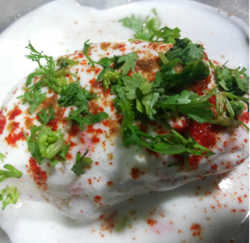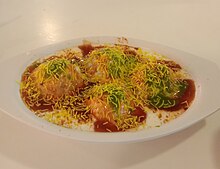Names
Dahi vada is also known as "dahi vade" (दही वडे) in Marathi, dahi barey/dahi balley (دہی بھلے/دہی بڑے) in Urdu, dahi bada/dahi vada (बड़ा बड़ा/दही वड़ा) in Hindi, dahi bhalla (دہی بھلا/ਦਹੀ ਭੱਲਾ) in Punjabi, thayir vadai(தயிர் வடை) in Tamil, [3] thairu vada(തൈര് വട) in Malayalam, perugu vada in Telugu, mosaru vade(ಮೊಸರು ವಡೆ) in Kannada, dahi bara (ଦହି ବରା) in Odia and doi bora (দই বড়া) in Bengali.
Preparation
Washed urad lentils are soaked overnight and ground into a batter for the vada, then cooked in hot oil. [7] The hot deep-fried vadas are first put in water and then transferred to thick beaten yogurt. The vadas are soaked for a period of time before serving. [7] Additions to the batter may also include golden raisins. Vadas may be topped with coriander or mint leaves, chilli powder, crushed black pepper, chaat masala, cumin, shredded coconut, green chilies, boondi, thinly sliced fresh ginger, or pomegranate. Sweeter curd is preferred in some places in India, especially in Maharashtra and Gujarat, although the garnishing remains the same. A combination of coriander and tamarind chutney is often used as a garnish. [7] The batter can be made using chickpea flour too. [8] [9]
This page is based on this
Wikipedia article Text is available under the
CC BY-SA 4.0 license; additional terms may apply.
Images, videos and audio are available under their respective licenses.









